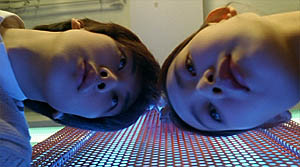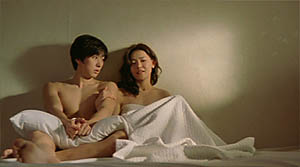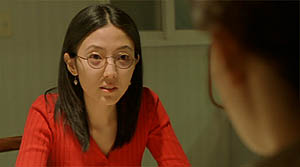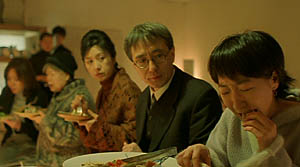Park Cheol-su is the author of an extensive filmography that goes back to the 70s. Among his most famous titles we can find 301-302 (1995) and Kazoku Cinema (1998). Along with his own production company, Park also runs a cinema school and organizes a DV-film festival in order to give young movie directors an opportunity to show their work.
At the Udine's Far East Film Festival, the director revealed that Green Chair came to light through the advice of a friend who suggested he should do a film based on something that usually sells very well – sex. Perhaps it is just a sardonic comment on the part of someone whose films usually fail the box office and which considers the South-Korean market to be strongly resistant to any works outside the mainstream.
Just his impression? The studio considered that the film would fail to target the commercial market and placed it on the shelf for a year and a half. Just in the middle of the year 2005, after being in film festivals – Sundance and Udine – did Green Chair had its premiere in South Korea movie theatres. Later, it was edited in DVD.
The difference in the ages of the protagonists is a base start in Green Chair, being a pretext to place the two characters "on the side" having to deal with a forbidden relationship. The brief isolation is a solution that appears to be impossible to turn around; first at the motel, then at Su-jin's (Oh) home, Mun-hi's artistic friend. The three of them form a sui generis familiar home circle that we question if it may last.
 |
 |
Nobody could predict that it would all start with a Roy Orbison "Best Of" crashing onto the floor. |
The age element provides a narrative structure that leads to the final sequence, where all the relevant characters in the film come together. On a limited space, the voices of the community are reproduced: parents, friends, old relations, even the Law itself impersonated. The relationship ends up being analyzed, questioned or sanctioned by those external elements, which Mun-hi and Hyeon must face and overcome.
There is a twisted sense of humour throughout the whole film, but the best moments come in the end, based on the interaction between the several characters. Those present play a role in the narrative on which Park is focused, rejecting any realism as the scene unfolds – it does not make any sense that even half of those people are there. It is as if they had all been invited by the director Park Cheol-su and not by the hostess Su-jin.
 |
 |
Su-jin (Oh Yun-hong) shelters the lovers in her home and hostesses the reunion where all the characters come together. |
Despite the suspension in realism, there is, in this segment of the film, what we might call an aesthetic documentary, motivated by the need to hear all the "statements" of some people regarding the protagonists' relationship. Thus, instead of writing dialogue and rationalizing the presence of all the characters, Park just induces them to open a door, enter and share their opinions with us. Those we have not met are introduced to us, with their relationships to the protagonists coming up on the screen. In some planes the explanations are given directly to the camera, as if we were also invited and those present shared with us their points of view.
In order for the film to work and so as not to feel that the main motivation is to attract the public based on the (supposed) polemic relationship between a woman in her thirties and a minor (although almost 20 years of age) — and on the extensive sex scenes between the two —, Park pulled out good performances from the main cast, led by Seo Jeong and young Shim Ji-ho. Adding Oh Yun-hong and a group of functional relevant secondary actors on a solid and mature text, the relationships between the characters become fully credible.
Still a word for the excellent photography, supported by natural light, effective composition and editing and a seductive original soundtrack, to complete a proposal for good cinema, which deserves to be presented to and appreciated by a much wider audience.

